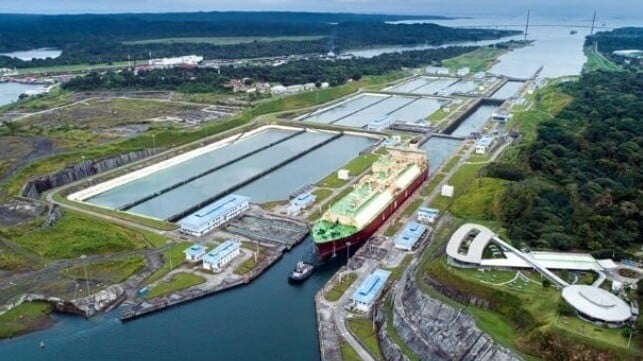Could Mega-Scale Pumping Solve Canal Transit Problems?

Reduced water depths occur along navigable inland waterways, disrupting the economics of waterway transportation. While technology capable of maintaining viable transportation along economically essential navigable waterways exists, the installation of such technology involves considerable political controversy. Authorities responsible for waterways may need to consider implementing drastic measures, for economic reasons.
Introduction
Periods of reduced water levels have occurred along several navigable inland waterways and adversely impacted domestic and international waterway transportation. During past such occasions, ships sailed the St. Lawrence Seaway at part load. Recent drought conditions reduced water levels through the Panama Canal and impacted international shipping. Reduced water levels have occurred along the European canal system, along sections of the Mississippi River and along the McKenzie River in northwestern Canada. During some past periods of low water levels, vessels carried reduced payload or had to cease navigation along shallow sections of waterway.
The European inland canal system and the New Panama Canal have been built with water saving side tanks at navigation locks. The tanks reduce water usage when vessels transit across changes of elevations. Despite such measures, weather conditions still reduced water depths and adversely impacted navigation. However, there are still alternative methods by which to respond when water depths decline along some navigable channels. Methods that involve changes to the infrastructure would be subject to environmental evaluation, with economic cost comparisons between environmental impact and revenue earned from ongoing ship transportation.
Infrastructure Modifications
The power generation industry uses pumped hydraulic storage as a means by which to store energy. There is scope to adapt some hydraulic pumping technology from the power industry to some navigable waterways. However, operators of inland waterway systems that seek to utilize such technology, would require access to massive amounts of electrical energy. One method by which to increase navigable water depths would be to pump seawater inland along the navigable waterway, to higher elevation. The combination of wind power and ocean water energy conversion could at some locations, pump seawater to higher elevation.
A nuclear generation ship moored near the entrance/exit of an inland would also have the capacity to generate large amounts of electric power to continually operate water pumps that transfer massive volumes of water to higher elevation. The Panama Canal Authority would need to evaluate the environmental impact of pumping seawater inland from the Pacific Ocean to sustain navigable water depths along the western section of the canal. The combination of two power utilities and the St. Lawrence Seaway would need to explore pumping water from the Ottawa River upstream from Montreal to sustain water depth to Lake Ontario.
Navigation Lock Water Pumps
When vessels need to transit to lower elevation, water pumps might transfer water upstream from navigation locks where water saving side tanks are absent. Such pumping of water would sustain water depths along the highest elevations along the navigation canal. The might be need to pump seawater into channels to sustain water levels at lower elevations. The canal operator and national government would need to compare the environmental impact cost of seawater on vegetation growing along the navigation channel, to the amount of revenue the canal earns and contributes to the national economy.
The installation of high – volume water pumps at some navigation locks along the Panama Canal might actually be viable in terms of ship transit revenue, despite the environmental impact on vegetation growing next to lower elevations of the canal. One possible option might be to plant mangrove along lower elevations of the canal that would receive pumped seawater. While the frequency and duration of future occurrences of drought over the watershed areas of Panama is unknown, the option of pumping water to higher elevation at navigation locks increases the duration of navigation during future periods of drought.
Additional Navigation Locks
Installing both navigation locks and water pumps at strategic locations along some navigable waterways offers the promise of sustaining water levels during periods of extended drought. In Eastern Canada, a navigation lock installed along the St. Lawrence River near Quebec City would sustain navigable water levels upstream to Montreal, with water levels downstream of such lock dropping to ocean levels while maintaining sufficient navigation depth for ships to sail between Montreal and the Atlantic Ocean. Potable water flowing from four rivers into the St. Lawrence River east of Quebec City would reduce salinity to the Gulf of St. Lawrence.
The St. Lawrence receives most of its water from the Great Lakes where water depth fluctuates by a few feet over an extended time duration. There have been periods when ships have sailed at reduced payload and reduced draft along the St. Lawrence Seaway due to reduced navigable water depth. On an almost cyclical pattern, such periods have been followed by successive multi-year periods of excess water height, which have on occasion restricted ship traffic or required ships to sail at reduced speed so as to minimize flooding and erosion along the shoreline.
Conclusions
The feasibility of national economies and of international trade depends on vessels sailing through navigable inland waterways. While changing weather patterns can reduce water depths along such waterways, proven technology and proven methods can maintain navigable depths over extended time duration. Implementing such methods and technology requires some governments to make drastic decisions, for economic reasons.
The opinions expressed herein are the author's and not necessarily those of The Maritime Executive.

